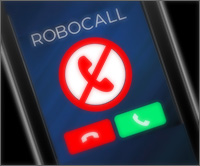New Year’s Resolution: A 2020 Vision to Spot Scammers
There’s no getting around it: Scams continue to evolve every year. The bad guys keep finding fresh ways to exploit good people, often using new technologies in their criminal deeds.
 Elder fraud. Identity theft. Financial exploitation. They all can jeopardize a lifetime of savings. But safeguards exist, and you can take important steps to protect yourself and your loved ones.
Elder fraud. Identity theft. Financial exploitation. They all can jeopardize a lifetime of savings. But safeguards exist, and you can take important steps to protect yourself and your loved ones.
Here are just three, taken from a longer list by the Federal Trade Commission:
Don’t trust Caller ID. Scammers are using technology to create fake names when they call you up – names you might trust, like a government agency. Requests for money or your personal information are usually red flags and you should hang up. If you really believe the call is legitimate, try to verify the number independently and then call back.
Search online for warning signs. When you have questions about a company or product, you can do an internet search that includes words like “scam,” “complaint” or “review.” You also can search for phrases like “IRS call”—a popular ruse used by crooks. If you have doubts about a phone number, check it out online.
Beware of “free” trial offers. We all get pitches to sign up for products at little or no initial cost. But make sure to read the fine print and ask questions, because rates sometimes soar after an initial period expires. Make sure you understand the cancellation policy, and review your monthly financial statements with care.
If you’re interested in news about scams, sign up for FTC Consumer Alerts, which cover fraud trends in a broad range of areas. Beyond that, a service such as EverSafe monitors bank and investment accounts, credit cards and credit data, and provides ongoing protection against fraud, scams and financial exploitation.
Fake Checks Can Cost You Plenty
This type of fraud takes many forms, but the basic idea stays the same: A crook sends the victim a check—that is worthless. The crook then comes up with a reason for the victim to send back some cash—that is real.
 Maybe the victim thought he or she was selling something to a legitimate buyer, perhaps through Craigslist or eBay. Or maybe the victim believed they had won a sweepstakes or was being paid to work at home. But the con artist’s check bounces. Older adults and retirees are often victims, but anyone can be a target.
Maybe the victim thought he or she was selling something to a legitimate buyer, perhaps through Craigslist or eBay. Or maybe the victim believed they had won a sweepstakes or was being paid to work at home. But the con artist’s check bounces. Older adults and retirees are often victims, but anyone can be a target.
In the latest version, scammers have targeted college students, offering to pay as much as $350 a week if they place advertising on their cars. The scammer then asks the target to send back some money that a “specialist” will use to place the advertising on the student’s car.
The American Bankers Association offers the following tips to protect yourself from fake-check fraudsters:
- Be aware that a check may be worthless—even if it clears initially. If you have questions about the validity of a check, raise them with your bank.
- Don’t be fooled by a check that looks “real.” Technology is helping crooks make counterfeit checks and money orders look more authentic than ever.
- Do not “pay to play.” If someone who claims to be giving you money is also asking you to send money back, that is likely a scam.
- Be careful where you send money. Before sending cash to someone you do not know, take steps to determine that they are legitimate.
- Report suspicions of fraud to your bank right away. Bank staffers should know how to spot phony checks.
Protect Yourself
Don’t Lose Money to “Abandoned” Accounts
It doesn’t get much attention, but one of the ways people lose money is by ignoring funds that are legally their own. If a state decides you have “abandoned” the account, it may take steps to take it away.
This little-known process goes by the name of “escheatment,” and it can affect a lot of people. Say you once set up a college savings account for a child who is now grown—but you never got around to emptying the account. Or you simply forgot about an old checking account or life insurance policy. Or you qualified for a tax refund that you never claimed, because you were distracted by other events. Those are just a few examples.
State laws vary, but if the money lies dormant for a period of time—often 3-5 years—states may consider it abandoned. The state may then take over the account. (The relevant financial institution is supposed to contact you, but do they have current information?)
The easiest way to avoid this hassle is to keep your financial accounts active. According to the Securities and Exchange Commission, there are several ways to establish this. These include: logging on to an account or contacting the institution about it, maintaining current contact information, and cashing any dividend checks sent to you. Online banking may make this easier.
Is there a chance you have cash in an account that the state has deemed abandoned? You can find out by going to https://unclaimed.org or https://www.missingmoney.com.
Risk Factor: Use That ATM Card with Care
 You probably know to be careful when you use an ATM machine. But it’s important to remember—each and every time you reach for that convenient debit card.
You probably know to be careful when you use an ATM machine. But it’s important to remember—each and every time you reach for that convenient debit card.
According to the American Bankers Association, certain precautionary measures will help protect you from crime and financial fraud at the ATM. Consumers should:
- Look for “skimming” devices that scammers installed to steal your data. Warning signs may include sticky residue, scratches or damage to the ATM, loose attachments on the card slot and resistance when you press the keypad.
- Make sure no one can see you enter your PIN. Use your free hand to shield the keyboard when you enter information.
- Always be aware of your surroundings, especially at night. If anything or anyone seems suspicious, don’t use the ATM.
- Have your card ready before you reach the ATM. Don’t fish around in your wallet or purse while you are standing there.
- Take receipts with you when you’re finished. Quickly secure your money rather than counting it out in public.
- If you are using a drive-up ATM, keep the doors locked and passenger window closed. If you are parking your car to use the ATM, lock it.
- Use a monitoring service to send alerts at the first sign of suspicious activity. There are easy-to-use tools that will send you alerts for your accounts, and those of your loved ones as well.
Well-lit, indoor ATM locations are more secure, according to the FBI, and those in remote spots are riskier. In tourist areas, ATMs are more likely to contain skimming devices that steal your data. If the machine fails to return your card at the end of your transaction, be sure to inform the bank.
By being careful and using common sense, you can help keep your info away from scammers.
A Glimmer of Good News
 While the scourge of robocalls continues in the new year, the government has taken a preliminary step to stem the tide. Late last year, and with little fanfare, Congress passed the TRACED Act, which takes some initial steps to limit these invasive calls.
While the scourge of robocalls continues in the new year, the government has taken a preliminary step to stem the tide. Late last year, and with little fanfare, Congress passed the TRACED Act, which takes some initial steps to limit these invasive calls.
Under the new law, punishments for illegal robocalls now reach $10,000 per call. Also, telephone companies will enable consumers to identify the source of calls—a process known as “authentication—which should make it harder for crooks to “spoof” targets by using phony numbers.
The Federal Communications Commission has yet to develop rules. And the law targets only calls defined as illegal (not merely a nuisance). So while it is no panacea, advocates say the law is a step in the right direction.